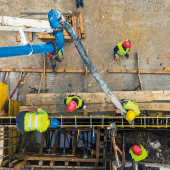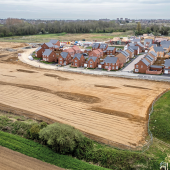NHBC makes recommendations to mitigate climate change risks to building foundations

A new National House Building Council (NHBC) Foundation report explores how the changing climate poses risks to the UK’s building structures and outlines the implications for the design and construction of their foundations. It also proposes recommendations for designers of building foundations and developers to help mitigate the risks when working on new builds.
Building Foundation Solutions – Future Proofing Against Climate Change identifies two key risk areas – the effects of changing weather patterns and increased canopy cover (trees) in building developments and urges industry to focus on climate change adaptation.
The NHBC Foundation had commissioned consultancy RSK to undertake the research, which included insights drawn from an online survey of industry professionals, including NHBC contacts and Association of Geotechnical and Geo-environmental Specialists (ASG) members.
The survey’s purpose was to produce a ‘snapshot’ of current industry perspectives in relation to climate change and considerations for the design and construction of building foundations.
In addition to these two key risk areas, the NHBC Foundation report also highlights how a building’s foundations contribute significantly to carbon emissions and the need to reduce the building’s overall carbon footprint to achieve the UK’s net zero targets.
As the report notes, this "includes 'direct' emissions associated with materials, earthworks, transport, plant and waste for the installation of foundations and “indirect” emissions through the relationship between foundations and carbon embodied in the rest of the building structures."
The new NHBC Foundation report builds on its 2007 publication Climate change and innovation in house building: designing out risk, which had identified a range of risks relating to climate change impacts. In relation to foundations, these included soil dry/shrink or swell/heave changes in water tables, increased risk of damage to subsoil water and increased risks to basements.
One of the new report’s aims was to consider these and other risks in greater detail, to document current understanding and to identify the implications for foundation design and construction, including where relevant, current NHBC Standards.
The report cites data from the Association of British Insurers (ABI) on insurance pay outs in response to property damage caused by storms Ciara and Dennis in early 2020, which revealed that flooding represented £214m of the total £363m in damage costs. In addition, 350 residential property flood claims had totalled an estimated £107m. The ABI had reported that the average cost of repairing a flood-damaged home was around £32,000.
More specifically in relation to building foundations, a different set of ABI data showed that 2018’s extreme summer heatwave had led to more than 10,000 households needing to claim for damage caused by subsidence, at a cost of more than £64m.
On the effects of weather patterns, the RSK’s industry survey identified a list of building defects that resulted from climate change impacts on foundations. These included claims for cracked buildings due to clay shrinkage/heave induced by high water levels and how extremely wet winters and dry summers both caused subsidence effects.
The new report, published earlier this month, highlights a number of key risks relating to the UK’s geological hazards, notably subsidence/heave in shrinkable cohesive soils; washout-induced damage or settlement; reduction in soil strength associated with increases in pore water pressure; and collapse settlements in earthworks and fills.
According to the report, the ‘current planning framework requires that the full range of potential hazards are considered at the earliest stages to ensure that appropriate measures and materials are incorporated into structural and foundation design to mitigate the risks’.
Although these procedures and standards have evolved over time, the report warns that the nature of the future changes is "without precedent".
As a result, the report says industry will need to ‘modify existing approaches to defining hazard risk potential (both in severity and likelihood) in line with future climate projections’ so that buildings are more resilient to climate changes.
In relation to the second key risk area highlighted, the report notes how increasing green infrastructure such as canopy cover does offer a wide range of benefits.
However, it adds that both new and existing trees pose significant direct and indirect risks to existing structures and infrastructure, including foundations.
Areas affected by shrink-swell are particularly vulnerable, the report warns. In its conclusion, the report advises that a ‘careful selection of suitable tree species and design of layouts to accommodate future tree growth without conflict is essential to minimise the potential risk of structural damage to buildings’.
On the issue of reducing carbon emissions to achieve net zero, and the contribution that foundations make to a building’s carbon footprint, the report suggests using lower carbon cement products or cement alternatives. The authors estimate these could result in a reduction in carbon emissions of between 30 and 50% compared to standard concrete.
The report notes that reducing carbon within foundations is being achieved in a variety of ways. These include pursuing ‘Modern Methods of Construction and other approaches to develop innovative lightweight building components leading to reduction in embodied and construction carbon; increased use of timber both in the substructure and superstructure; and retaining and reusing existing foundations, which is a viable option for higher density urban development.’
NHBC Foundation’s report also outlines recommendations for new builds. It advises designers of building foundations and developers to consider the identified climate change risks and associated geo-hazards and how these may vary over the lifetime of each development.
"Since it will take some time for further research to justify changes in the NHBC Standards or Building Standards, it is recommended that developers consider increasing their minimum foundation depths now to increase climate resilience rather than waiting for changes in standards to take place," concluded the report.
"However, this needs to be balanced against net-zero considerations and the need to reduce, rather than increase, embodied carbon associated with building construction, so alternative foundation options should also be considered."
The report calls for further research to explore the climate change risks and sustainable solutions for foundation design and construction. In addition, it calls for specific research to consider the resilience, economic, technical performance and ease of assessment of embodied carbon of foundation designs and materials.
"House builders must take climate change into consideration from design onwards, future-proofing their developments during the planning stage," said Richard Smith, Head of Standards, Research & Technical Competency at NHBC Foundation.
"This report focusses on foundation design and its application in making new homes more resilient to extreme weather events caused by climate change – a topical issue with growing relevance. We want to support developers and help educate the industry at an early stage about climate change resilience in house building, sharing best practice and straightforward guidance. The NHBC Foundation horizon scans to identify exactly these kinds of concerns and we were pleased to partner with RSK for this study."








